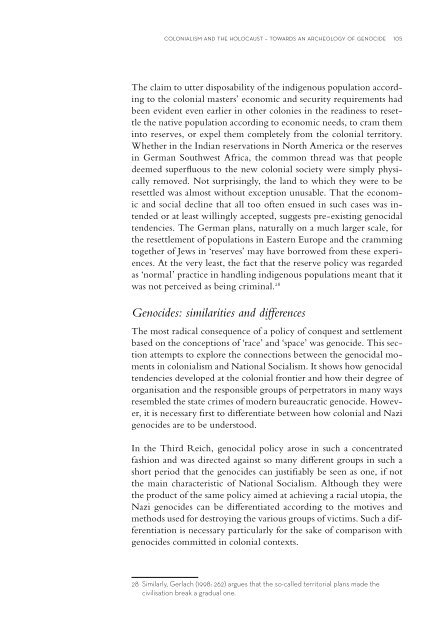60 years after the UN Convention - Dag Hammarskjöld Foundation
60 years after the UN Convention - Dag Hammarskjöld Foundation
60 years after the UN Convention - Dag Hammarskjöld Foundation
You also want an ePaper? Increase the reach of your titles
YUMPU automatically turns print PDFs into web optimized ePapers that Google loves.
colonialism and <strong>the</strong> holocaust – towards an archeology of genocide 105<br />
The claim to utter disposability of <strong>the</strong> indigenous population according<br />
to <strong>the</strong> colonial masters’ economic and security requirements had<br />
been evident even earlier in o<strong>the</strong>r colonies in <strong>the</strong> readiness to resettle<br />
<strong>the</strong> native population according to economic needs, to cram <strong>the</strong>m<br />
into reserves, or expel <strong>the</strong>m completely from <strong>the</strong> colonial territory.<br />
Whe<strong>the</strong>r in <strong>the</strong> Indian reservations in North America or <strong>the</strong> reserves<br />
in German Southwest Africa, <strong>the</strong> common thread was that people<br />
deemed superfl uous to <strong>the</strong> new colonial society were simply physically<br />
removed. Not surprisingly, <strong>the</strong> land to which <strong>the</strong>y were to be<br />
resettled was almost without exception unusable. That <strong>the</strong> economic<br />
and social decline that all too often ensued in such cases was intended<br />
or at least willingly accepted, suggests pre-existing genocidal<br />
tendencies. The German plans, naturally on a much larger scale, for<br />
<strong>the</strong> resettlement of populations in Eastern Europe and <strong>the</strong> cramming<br />
toge<strong>the</strong>r of Jews in ‘reserves’ may have borrowed from <strong>the</strong>se experiences.<br />
At <strong>the</strong> very least, <strong>the</strong> fact that <strong>the</strong> reserve policy was regarded<br />
as ‘normal’ practice in handling indigenous populations meant that it<br />
was not perceived as being criminal. 28<br />
Genocides: similarities and diff erences<br />
The most radical consequence of a policy of conquest and settlement<br />
based on <strong>the</strong> conceptions of ‘race’ and ‘space’ was genocide. This section<br />
attempts to explore <strong>the</strong> connections between <strong>the</strong> genocidal moments<br />
in colonialism and National Socialism. It shows how genocidal<br />
tendencies developed at <strong>the</strong> colonial frontier and how <strong>the</strong>ir degree of<br />
organisation and <strong>the</strong> responsible groups of perpetrators in many ways<br />
resembled <strong>the</strong> state crimes of modern bureaucratic genocide. However,<br />
it is necessary fi rst to diff erentiate between how colonial and Nazi<br />
genocides are to be understood.<br />
In <strong>the</strong> Third Reich, genocidal policy arose in such a concentrated<br />
fashion and was directed against so many diff erent groups in such a<br />
short period that <strong>the</strong> genocides can justifi ably be seen as one, if not<br />
<strong>the</strong> main characteristic of National Socialism. Although <strong>the</strong>y were<br />
<strong>the</strong> product of <strong>the</strong> same policy aimed at achieving a racial utopia, <strong>the</strong><br />
Nazi genocides can be diff erentiated according to <strong>the</strong> motives and<br />
methods used for destroying <strong>the</strong> various groups of victims. Such a differentiation<br />
is necessary particularly for <strong>the</strong> sake of comparison with<br />
genocides committed in colonial contexts.<br />
28 Similarly, Gerlach (1998: 262) argues that <strong>the</strong> so-called territorial plans made <strong>the</strong><br />
civilisation break a gradual one.

















